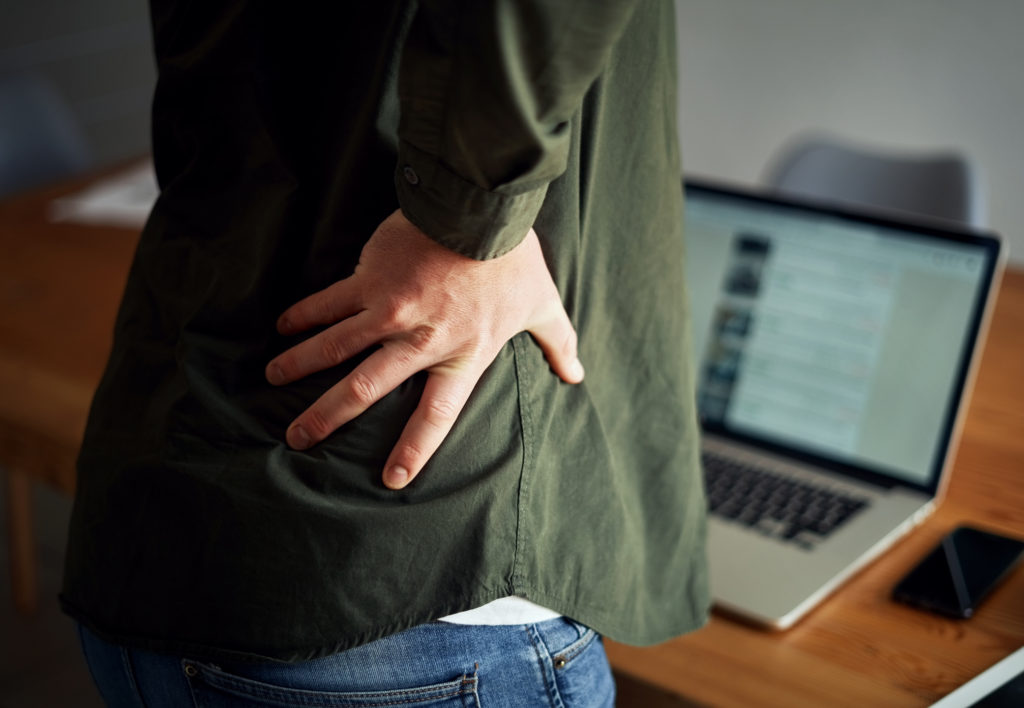
Low Back Pain in our Quarantine Lives
By: Rochelle Chung, Registered Physiotherapist
We are seeing a trend of low back pain and hip tightness resurfacing in our newly quarantined lives. This will likely be a function of a couple things: first of all, we are moving much less than before. Mechanically, our bodies are made to move and when we are placed in situations where we have to adapt, for example, being confined in a 500 square feet apartment or forced to share a cramped workspace with our partners, our tissues adapt, but not necessarily in a good way. We will fall into patterns that are the most comfortable for us, and subsequently, our tissues will end up being overloaded and tense in these positions. Our natural low back posture has an inward curvature, called a lordosis. If the curvature in our low back is lost for a prolonged period of time, such as when we’re sitting on a soft couch and binging through Netflix, it can cause tissues in our low back to fatigue or overload, causing low back problems and hip tightness.
Secondly and most often overlooked, is when low back pain and hip tightness emerges in the absence of any trauma and persists without help, this can lead into a hypersensitive nervous system. Our body has many ways of alarming you, and tightness and pain are one of the protective actions in our body that can occur. The brain, spinal cord and our body all work together to tell us how we should respond, however, when the nervous system is more excitable or stressed than usual, the system triggers you to be protected, and as such, these tissues in our low back and hips can further tighten. During life in the last few weeks with the pandemic in full fledged, our fight or flight response has been on overdrive - worrying about the health of our loved ones, stress about finances and trying to juggle homeschooling with looming work deadlines. As a Physiotherapist, we recognize the importance of distinguishing low back pain and hip tightness because of mechanical poor postures vs. pain and tightness coming from our poor emotional well-being and when our nervous system is in overdrive. We hold a lot of our emotions in our low back and hips, and when our mind-body is not as well connected during these uncertain times, this can translate into low back and hip pain or tightness.
Tips on easing these symptoms:
Whether your low back and hip tightness are caused by awkward sitting positions and or a hypersensitive nervous system the following tips can help:
Tip #1: Move often. After a long Zoom meeting or a TV binge session, I recommend you do a few popular yoga poses including a cobra, upward dog stretches or cat cow. These stretches will facilitate blood flow in our body and promote the tissues around our joints to move.
Tip #2: Use a lumbar roll in unsupportive chairs or soft couches. The goal of a lumbar roll is to restore the natural lordosis in your back, while overtime, you try to work at maintaining that posture. If you don’t have one at home, you can easily make one up with a rolled up towel and tie two pieces of string on either side..
Tip #3: Breathe. Take time to listen to your body and breathe. Stress and anxiety will cause tension to build up in our bodies. I recommend placing one hand on the belly and one on your chest, feel for the belly to rise and fall and develop a connection with calming breaths during these crazy times. Do this a few times during the day to help downplay the heightened nervous system.
General tips to help avoid acute low back pain:
Tip #1: Do a daily mobility program with intention. This can simply be going for a nice walk outside or an overall body mobility routine that helps with blood flow in the body.
Tip #2: Strengthen your low back and hip muscles without holding your breath. We are often taught to do “core” exercises and for most of us, we end up holding our breath. We need to remember that the contraction and relaxation of the muscles are equally important when we build strength.
Tip 3: Make time for mind-body connection. Make a list of movements or positions that decrease your tightness, it could be a stretch or being virtually socially engaged with friends/family, laughter or just your favorite music. Having a strong mind-body connection will help with persistent pain and prevention of secondary chronic issues that can develop.
 0 Comment
0 Comment 




Leave A Comment